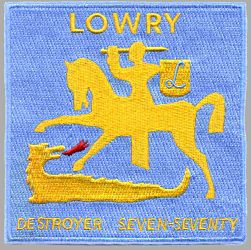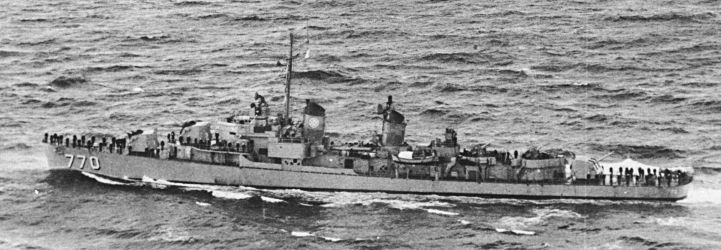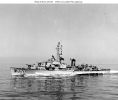

 |
Search the Site with

|
 |  |
USS LOWRY was an ALLEN M. SUMNER - class destroyer and the first ship in the Navy to bear the name. Decommissioned on October 29, 1973, and stricken from the Navy list two days later, the LOWRY was transferred to Brazil the same day and was recommissioned as ESPIRITO SANTO. She was scrapped in 1996.
| General Characteristics: | Awarded: 1942 |
| Keel laid: August 1, 1943 | |
| Launched: February 6, 1944 | |
| Commissioned: July 23, 1944 | |
| Decommissioned: June 30, 1947 | |
| Recommissioned: December 12, 1950 | |
| Decommissioned: October 29, 1973 | |
| Builder: Bethlehem Steel Co., San Pedro, Calif. | |
| FRAM II Conversion Shipyard: Norfolk Naval Shipyard, Portsmouth, Va. | |
| FRAM II Conversion Period: 1960 - January 1961 | |
| Propulsion system: four boilers, General Electric geared turbines; 60,000 SHP | |
| Propellers: two | |
| Length: 376.3 feet (114.7 meters) | |
| Beam: 41 feet (12.5 meters) | |
| Draft: 18.7 feet (5.7 meters) | |
| Displacement: approx. 3,180 tons full load | |
| Speed: 34 knots | |
| Aircraft after FRAM II: two DASH drones | |
| Armament after FRAM II: three 5-inch/38 caliber twin mounts, two Mk-10 Hedgehogs, Mk-32 ASW torpedo tubes (two triple mounts), two Mk-25 ASW torpedo tubes (removed prior to decommissioning) | |
| Crew before FRAM II: 336 |
Crew List:
This section contains the names of sailors who served aboard USS LOWRY. It is no official listing but contains the names of sailors who submitted their information.
USS LOWRY Cruise Books:
USS LOWRY History:
LOWRY was laid down 1 August 1943 by Bethlehem Steel Co., San Pedro, Calif.; launched 6 February 1944; sponsored by Miss Ann Lowry; and commissioned 23 July 1944, Comdr. L. H. Martin in command.
LOWRY cleared San Pedro 26 October 1944 for training at Pearl Harbor and arrived San Pedro Bay 14 December. From 19 to 29 December she escorted convoys between Leyte and the Mindoro Island beachhead, and was also part of a special striking force that helped protect Mindoro from enemy attack. From 2 to 10 January 1945 she operated as an effective task force screen and gunfire support ship in the invasion of Luzon, then patrolled the approaches to Lingayen Gulf guarding the newly won beachhead until sailing for Ulithi 22 January.
The destroyer departed Ulithi 10 February to screen fast carrier TF 58 for air strikes against Honshu in support of the Invasion of Iwo Jima. The force returned to Ulithi 1 March, from which LOWRY sailed 21 March for Okinawa to screen the support carrier group for the invasion until 29 April. LOWRY then served as radar picket off Okinawa. During this hazardous assignment, the ship engaged in numerous actions with enemy aircraft. The heaviest of these occurred 28 May, when accompanying picket destroyer DREXLER (DD 741) was hit by two suicide planes and sank with heavy loss of life. LOWRY, after fighting valiantly to prevent the loss of her companion, stood by to rescue survivors despite the continued presence of enemy aircraft in the area. From 29 June she covered minesweeping operations in the South China Sea, then arrived San Pedro Bay 27 July. For her valiant work as radar picket she was awarded the Navy Unit Commendation.
LOWRY joined fast carrier TF 38 off Tokyo 24 August for occupation duty during which she furnished food to Allied prisoners of war until 1 October, when she sailed for Okinawa to embark passengers for the United States.
Arriving San Diego 21 October for overhaul and west coast training, LOWRY left San Francisco 14 July 1946 for Kwajalein to patrol during Operation "Crossroads", the Bikini atom bomb tests. She was on station from 24 July to 10 August, when she sailed for San Diego, arriving 22 August.
Training off the west coast and in the Hawaiian Islands was broken in May 1947 when she visited Sydney, Australia, for the anniversary of the Battle of the Coral Sea. Returning to San Diego 14 June, she decommissioned 30 June 1947 and entered the Pacific Reserve Fleet.
LOWRY recommissioned 27 December 1950, Comdr. C. H. Morrison, Jr., in command. Assigned to the Atlantic Fleet, she arrived New York 30 April 1951, was overhauled at Norfolk, and in August began training exercises in the Caribbean, returning to Norfolk 15 November. On 22 January 1952, LOWRY sailed, via the Panama Canal, to join the 7th Fleet, arriving Yokosuka 27 February. With TF 77, LOWRY served off the east coast of Korea on shore bombardment, plane guard, and screening duty until early April, then had similar duty off the west coast of Korea with TF 95, the U.N. Blockading and Escort Force, through May. On 8 June, she sailed to rejoin TF 77 for gunstrike missions. Sailing via the Suez Canal and the principal Mediterranean ports, LOWRY arrived Norfolk 19 August.
Between 19 August 1952 and 1 February 1954, LOWRY made training cruises to the Caribbean and off Florida, engaging in intensive exercises to increase her combat efficiency. She departed Norfolk 1 February for her second world cruise, arriving Yokosuka from the Panama Canal 9 March. After a number of simulated combat exercises, including a full-scale mock invasion of Iwo Jima, she left Yokosuka 29 June for Suez, completing her second circumnavigation at Norfolk 25 August.
Training along the coast and in the Caribbean prepared LOWRY for her first deployment with the 6th Fleet in the Mediterranean, for which she left Norfolk 7 November 1956, returning to Norfolk 28 February 1957 for renewed training and overhaul. She again left Norfolk 3 September for NATO "Strikeback" exercises in the North Atlantic, continuing on to the Mediterranean from which she returned to Norfolk 22 December.
Her third tour with the 6th Fleet, 7 August 1959 to 26 February 1960, was followed by a FRAM II overhaul at Portsmouth Naval Shipyard, completed 14 January 1961.
In June 1961, LOWRY joined Antisubmarine Warfare Task Group Alfa, a special force engaged in research and development. She served in this force for the major part of the next 4 years, which included such operations as the rescue of Astronaut Virgil Grissom successfully completing the second American space flight 21 July 1961, and the Naval Quarantine of Cuba which played the major role in ending the Cuban missile, crisis of October-November 1962.
After her fourth Mediterranean deployment, 18 February 1965 to 12 July, LOWRY had the DASH system installed, then participated in a large Atlantic Fleet operational exercises. Her 1966 6th Fleet deployment, 4 March to 12 August, was followed by duty as schoolship for the Fleet Sonar School, Key West. Through most of January and February 1967, LOWRY embarked several Peruvian midshipmen for training under the Midshipmen Exchange Program. From 8 May through 22 September she underwent regular overhaul at Norfolk Naval Shipyard, followed by refresher training out of the Fleet Training Center, Guantanamo Bay, Cuba.
LOWRY departed Norfolk early in April 1968 for the Panama Canal, thence for the Far East on her first 7th Fleet deployment of the Vietnam conflict. Serving off the coast of that troubled country, she performed plane guard, naval gunfire support, and other duties. Highlight of port visits was a trip to Bangkok, Thailand. She arrived back at Norfolk 27 November, and continued Atlantic coast operations into 1969.
LOWRY received four battle stars for World War II service and two for Korean service.
About the Ship's Name:
Reigert Bolivar Lowry was born 14 July 1826 in La Guaira, Venezuela, the son of U.S. Consul Robert K. Lowry. Appointed midshipman 21 January 1840, Lowry served in the Mexican War and was a member of Commodore Matthew C. Perry's expedition to Japan in 1855. He served with distinction in the Civil War, commanding George W. Peabody in the Hatteras Expedition of August 1861, serving as executive officer in BROOKLYN during the capture of New Orleans and the first attack on Vicksburg (April-June 1862), and commanding SCIOTA in extensive river operations. His last command was Naval Station New London. He died at Brooklyn Naval Hospital 25 November 1880.
USS LOWRY Image Gallery:
 |
 Back to Destroyers list.
Back to Destroyers list.  Back to ships list.
Back to ships list.  Back to selection page.
Back to selection page.  Back to 1st page.
Back to 1st page.